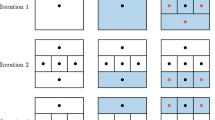Abstract
Goldfarb's algorithm, which is one of the most successful methods for minimizing a function of several variables subject to linear constraints, uses a single matrix to keep second derivative information and to ensure that search directions satisfy any active constraints. In the original version of the algorithm this matrix is full, but by making a change of variables so that the active constraints become bounds on vector components, this matrix is transformed so that the dimension of its non-zero part is only the number of variablesless the number of active constraints. It is shown how this transformation may be used to give a version of the algorithm that usually provides a good saving in the amount of computation over the original version. Also it allows the use of sparse matrix techniques to take advantage of zeros in the matrix of linear constraints. Thus the method described can be regarded as an extension of linear programming to allow a non-linear objective function.
Similar content being viewed by others
References
R.H. Bartels, G.H. Golub and M.A. Saunders, “Numerical techniques in mathematical programming”, Computer Science Rept. 70-162, Stanford University (1970).
R.H. Bartels, “A stabilization of the Simplex Method”,Numerische Mathematik 16 (1971) 414–434.
A.G. Buckley, “A revised implementation of Goldfarb's minimization algorithm”, T.P. Rept. 544, U.K. A.E.R.E., Harwell, England (1973).
A.R. Colville, “A comparative study on nonlinear programming codes”, Rept. 320-2949. IBM New York Science Center (1968).
A.R. Curtis and J.K. Reid, “Fortran subroutines for the solution of sparse sets of linear equations”, Rept.R. 6844, U.K. A.E.R.E., Harwell, England (1971).
R. Fletcher and M.J.D. Powell, “A rapidly convergent descent method for minimization”,The Computer Journal (1963) 163–168.
R. Fletcher, “Minimizing general functions subject to linear constraints”, in: F.A. Lootsma, ed.,Numerical methods for non-linear optimization (Academic Press, New York, 1971).
D. Goldfarb, “Extension of Davidon's variable metric algorithm to maximization under linear inequality and equality constraints”,SIAM Journal on Applied Mathematics 17 (1969) 739–764.
J. Kowalik and M.R. Osborne,Methods for unconstrained optimization problems (Elsevier, New York, 1968).
M.J.D. Powell, “Unconstrained minimization and extension for constraints”, Rept. T.P. 495, U.K. A.E.R.E., Harwell, England (1972).
J.K. Reid, Harwell Rept., U.K. A.E.R.E., to appear.
J.B. Rosen, “The gradient projection method for nonlinear programming, Part I. Linear Constraints”,SIAM Journal on Applied Mathematics 8 (1960) 181–217.
P. Wolfe, “Methods of nonlinear programming”, in: J. Abadie, ed.,Nonlinear programming (North-Holland, Amsterdam, 1967).
Author information
Authors and Affiliations
Rights and permissions
About this article
Cite this article
Buckley, A. An alternate implementation of Goldfarb's minimization algorithm. Mathematical Programming 8, 207–231 (1975). https://doi.org/10.1007/BF01580443
Received:
Revised:
Issue Date:
DOI: https://doi.org/10.1007/BF01580443




